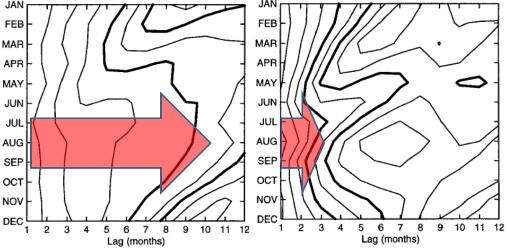The persistence of summer sea surface temperature anomalies (SSTAs) shows strong seasonal dependence, which might prove useful as reference for seasonal to interannual climate predictions. For the North Pacific, previous studies on SSTA persistence and large-scale air–sea interaction have tended to focus on the cold season. However, there is an evident contradiction for the persistence of summer SSTAs (Fig. 1).

Fig. 1. Lag correlation of SSTAs as a function of the start month (ordinate) and lag month (abscissa): leading principal component of the North Pacific SSTA (left); SSTA over (32°N, 159°W) (right). Contour interval: 0.1; the 0.4 and 0.6 contours are thickened.
Associate Professor Xia Zhao and Jing Wang, from the Institute of Oceanology, Chinese Academy of Sciences, and Assistant Professor Guang Yang, from the First Institute of Oceanography, State Oceanic Administration, investigated the persistence of summer SSTAs in the North Pacific. Their findings, published in Advances in Atmospheric Sciences (Zhao et al., 2018), show that summer SSTAs can persist for a long time (approximately 8–14 months) around the Kuroshio Extension region.
In addition, they also examined its mechanism and interdecadal variability. Associate Professor Xia Zhao explains what they discovered:
“This long persistence may be strongly related to atmospheric forcing, because the mixed layer is too shallow in the summer to be influenced by the anomalies at depths in the ocean. The longwave radiation flux has a dominant influence. The effect of shortwave radiation flux anomalies is not significant. This result is different from that of the previous studies.”
Associate Professor Jing Wang and Assistant Professor Guang Yang further indicate that the persistence of summer SSTAs displays pronounced interdecadal variability around the KE region, which appears very weak during 1950–82, but becomes stronger during 1983–16.
References
Zhao, X., G. Yang, and J. Wang, 2018: Persistence of summer sea surface temperature anomalies in the midlatitude North Pacific and its interdecadal variability. Adv. Atmos. Sci., 35(7), https://link.springer.com/article/10.1007/s00376-017-7184-1 .
Contact: Ms. Fengfan Yang Email:fengfanyang@qdio.ac.cn

